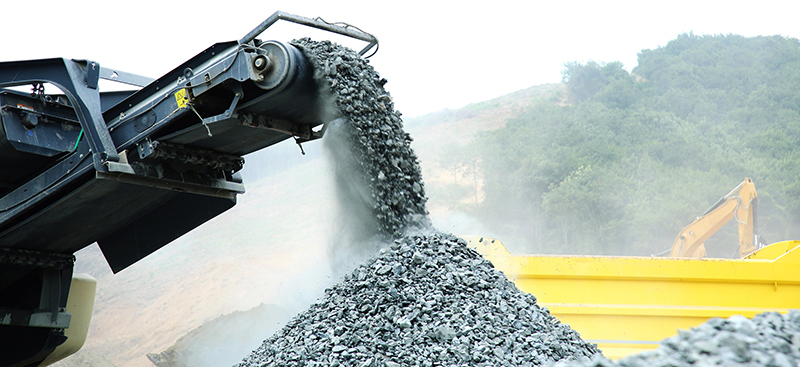By Andrew Askew, owner of MINORE, which specialises in sustainable solutions within the minerals sector
A number of reforms and policy updates in relation to planning and green infrastructure have been outlined recently. This includes a Planning and Infrastructure Bill with the aim of reducing red tape to provide new homes, commercial development and promote sustainable infrastructure.
An essential part of these large and complex construction projects, biodiversity, restoration and land remediation works, is the machinery, equipment and apparatus required for these activities. As it strives to meet the goal of achieving net zero carbon emissions by 2050, set out in evolving environmental regulations, the sector will need to adapt operations, adopt new green skills and technologies, and explore the use of alternative materials.
Reuse of materials is particularly vital in the construction sector. The World Economic Forum’s ‘Shaping the Future of Construction’ report indicates that the sector is the world’s largest consumer of raw materials, using over three billion tonnes annually. The sector is experiencing soaring costs for construction materials due to global supply chain disruptions and increased demand, whilst an ongoing shortage of skilled labour puts added pressure on project timelines.
Many materials can be repurposed and recycled to create new and exciting products, following circular economy principles. Yet ‘Circular Material Use Rate in Europe’ analysis by the European Environment Agency published in February 2024, indicates recycled material accounted for 11.5% of material used. This marks a marginal increase of less than one percentage point since 2010.
Clay minerals role in carbon reduction
The composition, mineralogy, and properties of clay mineral products make them highly effective for many environmental initiatives within construction works. Here’s how those three factors contribute to its suitability for use in a range of carbon reduction and environmental projects:
1) Land remediation and soil improvement: The cation exchange capacity in clay minerals make them suitable for soil remediation by immobilising contaminants. The mixed mineralogy of illite, kaolinite, and mixed layer illite/smectite helps to reduce soil contamination and enhances fertility in degraded soils. The neutral pH range makes the clay compatible with most soil systems and minimises adverse pH-related effects on plants and microorganisms.
2) Carbon sequestration and biodiversity: Adopting advanced innovations, like carbon capture, utilisation, and storage (CCUS) systems, can be an expensive undertaking for businesses, especially in the cement and low carbon construction products sectors. This can make organisations hesitant to allocate resources to them at this point, and with shifting environmental regulations, businesses may view this investment as risky and premature. Affordable and low-risk carbon solutions, therefore, need to be made accessible to businesses.
Clay has immense promise for enhancing carbon reduction initiatives. The mixed mineralogy within the clay, including kaolinite and illite minerals are effective in carbon capture. Mineral-rich, clay compositions can be used to enhance the effectiveness of supplementary cementitious materials (SCMs), thereby easing the transition to greener alternatives in cement production.
3) Waste containment and barrier layers: The presence of smectite and illite provides a low permeability barrier, ideal for lining landfills or containing hazardous materials.
4) Industrial by-products management: Neutral pH and prominent oxides allow the clay to neutralise acidic by-products, such as those from mining operations.
5) Heavy metal adsorption: Goethite, hematite, and smectite enhance the binding of heavy metals, helping to stabilise industrial waste.
6) Applications in biodiversity net gain (BNG) initiatives: Its mineral and chemical properties align with requirements for restoring natural habitats and creating biodiverse subsoils, supporting vegetation growth and water management.
7) Recycling of materials once deemed obsolete: Innovative methods are being developed to recycle construction and demolition waste, presenting eco-friendly options for future construction material supply. For example, discarded minerals sourced from local construction and demolition projects and waste management facilities can be repurposed or used to develop speciality mineral formulations. These tailored blends of mineral rich, clay compositions can aid resource efficiency in the above environmental and infrastructure projects and can be used by aggregate businesses and in road construction and development, for example.
Repurposing this material reduces the need for quarrying virgin aggregate, diverts unnecessary waste from landfill and promotes circular and sustainable construction practices.
Future outlook
Investing in carbon capture technologies is essential for sustainability and emission reductions, whilst demand for sustainable materials is rapidly increasing. Integrating supplementary cementitious materials (SCMs) will lower carbon footprint while meeting profit expectations with minimal capital.
To lead in a decarbonising market, quick and decisive action is essential. The sector will need to adapt strategies to pioneer affordable, innovative sustainable practices to seize emerging market opportunities, maintain competitive advantage and meet regulatory demands.











